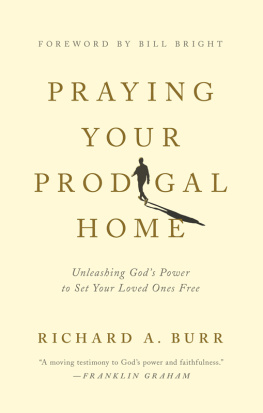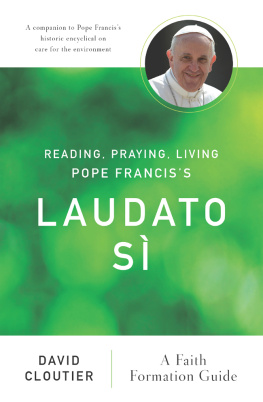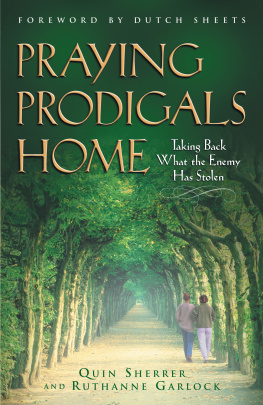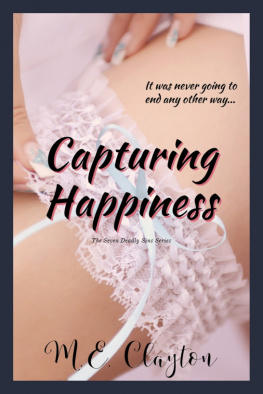David Clayton - The Little Oratory: A Beginners Guide to Praying in the Home
Here you can read online David Clayton - The Little Oratory: A Beginners Guide to Praying in the Home full text of the book (entire story) in english for free. Download pdf and epub, get meaning, cover and reviews about this ebook. year: 2014, publisher: Sophia Institute Press, genre: Religion. Description of the work, (preface) as well as reviews are available. Best literature library LitArk.com created for fans of good reading and offers a wide selection of genres:
Romance novel
Science fiction
Adventure
Detective
Science
History
Home and family
Prose
Art
Politics
Computer
Non-fiction
Religion
Business
Children
Humor
Choose a favorite category and find really read worthwhile books. Enjoy immersion in the world of imagination, feel the emotions of the characters or learn something new for yourself, make an fascinating discovery.
- Book:The Little Oratory: A Beginners Guide to Praying in the Home
- Author:
- Publisher:Sophia Institute Press
- Genre:
- Year:2014
- Rating:5 / 5
- Favourites:Add to favourites
- Your mark:
- 100
- 1
- 2
- 3
- 4
- 5
The Little Oratory: A Beginners Guide to Praying in the Home: summary, description and annotation
We offer to read an annotation, description, summary or preface (depends on what the author of the book "The Little Oratory: A Beginners Guide to Praying in the Home" wrote himself). If you haven't found the necessary information about the book — write in the comments, we will try to find it.
The Little Oratory: A Beginners Guide to Praying in the Home — read online for free the complete book (whole text) full work
Below is the text of the book, divided by pages. System saving the place of the last page read, allows you to conveniently read the book "The Little Oratory: A Beginners Guide to Praying in the Home" online for free, without having to search again every time where you left off. Put a bookmark, and you can go to the page where you finished reading at any time.
Font size:
Interval:
Bookmark:
T HE L ITTLE O RATORY
A B EGINNERS G UIDE TO
P RAYING IN THE H OME
B Y D AVID C LAYTON AND
L EILA M ARIE L AWLER
I LLUSTRATIONS BY D AVID C LAYTON
AND D EIRDRE M . F OLLEY
SOPHIA INSTITUTE PRESS
Manchester, New Hampshire
Copyright 2014 David Clayton and Leila M. Lawler
Interior art: Line drawings of the Transfiguration, the Nativity, the Visitation, the Temptation of Christ, Christ in Majesty, King David, St. Christopher, the Annunciation, the Presentation, the Agony in the Garden, the Face of Christ, and the Vladimir Mother of God Copyright 2014 David Clayton; all other black and white images Copyright 2014 Deirdre M. Folley.
Printed in the United States of America
All rights reserved
Cover design by Coronation Media in collaboration with Perceptions Design Studio.
Except where otherwise noted, biblical references in this book are taken from the Revised Standard Version of the Bible, copyright 1952 (2nd edition, 1971) by the Division of Christian Education of the National Council of the Churches of Christ in the United States of America. Used by permission. All rights reserved.
No part of this book may be reproduced, stored in a retrieval system, or transmitted in any form, or by any means, electronic, mechanical, photocopying, or otherwise, without the prior written permission of the publisher, except by a reviewer, who may quote brief passages in a review.
Sophia Institute Press
Box 5284, Manchester, NH 03108
1-800-888-9344
www.SophiaInstitute.com
Sophia Institute Press is a registered trademark of Sophia Institute.
Library of Congress Cataloging-in-Publication Data
Clayton, David (David N.)
The little oratory : a beginners guide to praying in the home / by David Clayton and Leila M. Lawler.
pages cm
ISBN 978-1-62282-176-1 (pbk. : alk. paper) eBook ISBN 978-1-622821-77-8 1. Prayer Catholic Church. 2. Families Religious life. 3. Spiritual life Catholic Church. I. Lawler, Leila M. II. Title.
BV210.3.C56 2014
249 dc23
2013045612
To my wife, Edna, in gratitude for her support, and our daughter, Victoria; to my father and mother, Stuart and Mary; and to the late David Birtwistle D.C. To my family L.M.L. C ONTENTS A BOUT THE I MAGES
A t the back of this book are eight color plates of sacred art. These can be easily removed and are a standard size for affordable mounting and framing for your prayer corner. Each is a reproduction of a painting by David Clayton.
If you want a larger image, you may download and print one in color from this site: www.SophiaInstitute.com/LittleOratory. You will also find several images of original Gothic illuminations from the Westminster Psalter , all the other images of sacred art included in this book as line drawings, and several more that are not in the book. You may like to print these to use as models to copy if you are teaching (or learning) to draw iconographic and Gothic-style images. They also make beautiful coloring pages.
You can commission work from David Clayton through http://thewayofbeauty.org.
The other illustrations, which are interspersed throughout the text, are by Deirdre M. Folley. You can commission work from her through www.deirdrefolley.com.
Consult chapter 3 for suggestions about the choice and placement of the main elements of the artwork in your home.
THE COLOR PRINTS
A crucifixion in the early Gothic style . This Franciscan cross, an image of the suffering Christ, can be the centerpiece of your little oratory. The original hangs in the chapel of Thomas More College of Liberal Arts in Manchester, New Hampshire.
2. and 3. Images of our Lady and our Lord . One is Gothic (with the blue shawl) and one iconographic in style.
4. and 5. These are images of Christ in glory . One is Christ sitting on His heavenly throne, with the four Evangelists (Matthew is symbolized by the angel, Mark by the lion, Luke by the ox, and John by the eagle) carrying the Word off to the four corners of the world. The second image is called a Mandylion (or Image of Edessa), the face of the Savior on a cloth; in the West there is a similar tradition of Veronicas veil. Tradition holds that the original was not painted by man: the icon was created when Veronicas veil was taken to Edessa, where a miraculous healing occurred. Then artists copied this original.
You may like to put the remaining images in your little oratory or elsewhere in your home.
The Visitation . This image is based on the late-twelfth-century English illuminated manuscript the Westminster Psalter . It depicts Our Ladys meeting with her cousin Elizabeth.
St. Michael slaying the dragon . The heavenly drama is played out and won eternally. John Paul II exhorted the faithful to revive the tradition of praying for the intercession of the powerful archangel Michael against the forces of darkness. You can hear a wonderful musical setting for the prayer to St. Michael at the website The Way of Beauty: http://thewayofbeauty.org. The sheet music is also available.
King David . This image is based on an original from the Westminster Psalter . King David was the composer of the Psalms, the book that St. Thomas Aquinas declared contains all of theology.
THE LINE DRAWINGS
Chapter 1: The Transfiguration
Chapter 2: The Nativity
Chapter 3: The Visitation (after the Westminster Psalter ), at which Mary sings the Magnificat, sung at Vespers
Chapter 4: The Temptation of Christ
Chapter 5: Christ in Majesty
Chapter 6: King David
Chapter 7: St. Christopher carrying the Child Jesus (after the Westminster Psalter )
Chapter 8: The Annunciation (after the Westminster Psalter )
Chapter 9: The Presentation in the Temple, at which Simeon sings the Nunc Dimittis, sung at Compline
Chapter 10: The Agony in the Garden
Chapter 11: The Face of Christ
Chapter 12: The Vladimir Mother of God
DO WE WRITE OR PAINT ICONS?
A note from David Clayton:
When people discuss icons, some insist that the word paint is inappropriate and that one ought to talk about writing icons. The reason usually given is that we are visually representing the Word of God, and words are written, not painted.
My study of the issue reveals that the Greek verb used to describe the creation of an icon can be translated as either to paint or to write. The Orthodox themselves are not unified on this matter. Most of those I know who are painters of icons dont really care what you call what they do. For example, my teacher, who is very well respected in the Eastern Orthodox world, said he thought it was a bit precious to insist on using the verb to write in English.
To my mind, if I am creating a work by applying paint with a paintbrush, that is called painting. It doesnt lower the status of an icon by considering it to have been painted rather than written.
Regardless of what you choose to call the art of making an icon, there is no justification for applying one word to icons and another to the other authentic liturgical traditions of sacred art, for instance, the Gothic and the Baroque. The iconographic style is not inherently superior to other liturgical forms, and there are no writings of Church Fathers that even suggest it (although you might not believe it to talk to some people today).
W HAT I S T HIS B OOK A BOUT?
W e have tried with this book to answer a very basic question: How can I be Catholic in between the times when I am worshipping in church; and especially, how can I be Catholic at home? In short, how can I live a unified life of faith?
Next pageFont size:
Interval:
Bookmark:
Similar books «The Little Oratory: A Beginners Guide to Praying in the Home»
Look at similar books to The Little Oratory: A Beginners Guide to Praying in the Home. We have selected literature similar in name and meaning in the hope of providing readers with more options to find new, interesting, not yet read works.
Discussion, reviews of the book The Little Oratory: A Beginners Guide to Praying in the Home and just readers' own opinions. Leave your comments, write what you think about the work, its meaning or the main characters. Specify what exactly you liked and what you didn't like, and why you think so.













